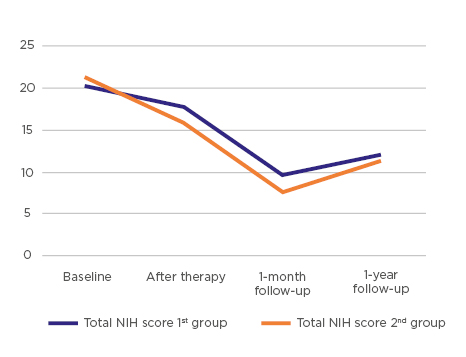BACKGROUND AND AIMS
Extracorporeal shock wave therapy (ESWT) for chronic prostatitis (CP) is a popular method because it does not require prescription of medicines, and therefore can be used in patients with allergies.
The aim of this study was to estimate long-term efficacy of ESWT as monotherapy for CP/chronic pelvic pain syndrome (CPPS), establish the maintenance of the treatment effect for up to 1 year post-treatment, and conclude whether the patients were in need of further sessions.
MATERIALS AND METHODS
Of the total 49 CP/CPPS patients enrolled in the study, 27 patients had CP/CPPS Category III-a (first group) and 22 patients had CP/CPPS Category III-a complicated with prostatic calculi (second group). Inclusion criteria were National Institute of Health Chronic Prostatitis Symptom Index (NIH-CPSI) scores ≥15, as well as signed informed consent. ESWT was performed with Dornier Aries (Dornier MedTech Systems GmbH, Weßling, Germany) as monotherapy. For the first group, the protocol was two procedures per week for 3 weeks, totalling a complete course of six procedures. Patients of the second group received the same therapy, but, because they had disease complicated by prostatic calculi, they received eight procedures over 4 weeks, again receiving treatment twice a week.
Efficiency was evaluated by a NIH-CPSI score calculated directly after the end of ESWT, and at 1-month follow-up (first group) and 3-month follow-up (second group). Additionally, in both groups long-term efficiency was estimated in 1-year follow-up after ESWT had finished.
RESULTS
For 1-year follow-up, 23 patients (85.2%) in the first group and 18 patients (81.8%) in the second group were available. During this period, seven patients (24.1%) in the first group and nine patients (50.0%) in the second group had relapse of CP/CPPS and were treated with ESWT repeatedly. However, some patients in both groups were well for the full 12 months following ESWT, despite having 1–2 relapses of CP/CPPS every year prior to receiving ESWT.
Results were worse in the 1-year follow-up than in the 1-month after the course of ESWT, but better than baseline. NIH-CPSI scores showed statistically significant improvement in all parameters in both groups, with maintenance of the effect without any significant side-effect of the treatment over the 12 months (Figure 1).

Figure 1: Long-term results of extracorporeal shock wave therapy for treatment of Category III-a chronic prostatitis.
NIH: National Institute of Health.
CONCLUSION
This study demonstrates the safety and efficacy of ESWT for at least 1-year post-treatment in CP/CPPS, including in patients complicated by prostatic calculi. Only 24.1% of patients with CP/CPPS Category III-a and 50.0% of CP/CPPS Category III-a complicated with prostatic calculi needed a repeated course of ESWT after completion of the first course.








